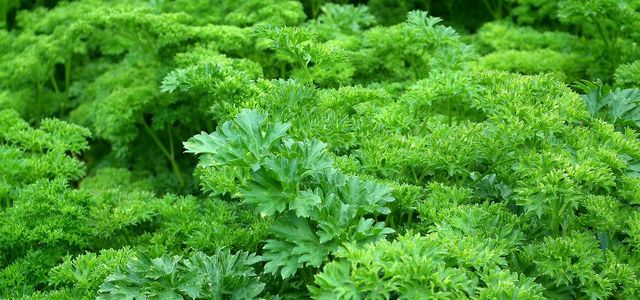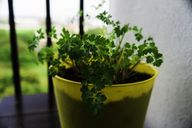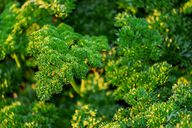
Parsley is a versatile culinary herb and can be easily planted in a pot or in the garden. We explain how to plant and care for parsley properly.
Parsley belongs to the umbellifer family and is a very popular kitchen herb. In Europe, it is mainly the curly parsley that is known. However, there are different types of parsley. In addition to the curly parsley, there are also species with smooth leaves. Flat-leaf parsley is considered to be particularly aromatic.
Parsley belongs to the biennial plants. This means that after sowing, you can harvest parsley for two years before the plant flowers and then stops growing leaves.
Contents
Plant parsley in pot
You can often buy parsley in the supermarket already grown in a pot. Since the ready plants in the store are usually already strongly rooted, you should repot the parsley in a larger pot as soon as possible after purchase.
If you want to plant parsley yourself, you can also buy seeds in stores or online, for example, at **Amazon. When buying seeds, make sure the bags are undamaged. Seeds from damaged bags may have become unusable or infested with pests.
The best time to plant parsley in a pot is in late summer. Then the parsley comes up faster and you can soon start harvesting the leaves.
The right place and care for parsley in a pot
Parsley likes partial shade locations. So it is best not to place the pot in full sun. If you have a balcony or a garden, place the parsley in a semi-shaded, wind-protected location.

As far as care is concerned, parsley is relatively undemanding:
You should only make sure when watering that the soil in the pot does not become too moist. Parsley does not tolerate waterlogging.
You can use the thumb test to check whether the soil is still moist before watering. To do this, feel with your thumb whether there is still enough moisture in the pot. If this is the case, you can wait a little longer before watering.
If you are sowing parsley from scratch, you should always keep the soil moist. In the beginning, you can cover the pot with a fleece to keep the moisture in the soil.
Parsley germinates best at slightly higher temperatures. In the beginning it is best to grow the plant indoors.
After that, you can either grow it indoors in a semi-shaded, slightly cooler place or put it outside on the balcony or in the garden.
Planting parsley in the garden
Also in the garden bed parsley grows best in partial shade locations. The soil should be well-drained, rather sandy and rich in humus. You can already enrich your bed with compost or organic fertilizers in the fall to increase the nutrient content in the soil.
For a summer and fall harvest, you can sow parsley starting in mid-March.
Plant the seeds about one to two inches deep in the soil. The rows should be spaced about 20 to 30 inches apart.
Parsley has a germination period of about three to four weeks. During this time, you should make sure that the soil is always moist and that no weeds grow on the bed.
To keep the soil moist, you can also cover your bed with a fleece until the parsley has germinated.
If you want to harvest parsley even in winter, you can still sow in July. In this case, however, cultivation in a greenhouse is recommended.
How to properly care for it in the garden bed
Since parsley needs a lot of moisture, the soil in the bed should also always contain enough moisture. However, you must also avoid waterlogging here.
Except for fertilizing in the beginning, parsley does not need any additional fertilizer. To promote the resprouting of the kitchen plant after the harvest, you can regularly loosen the soil with a hoe. In addition, you should always keep the bed free of weeds.
Parsley does not get along well with all plants. So if you want to grow more plants on the bed, you should choose the right neighbors. Parsley gets along well with tomatoes or chives, for example. Lettuce, on the other hand, prevents parsley from growing and should always be planted with sufficient distance.

How to harvest parsley correctly
You can harvest the leaves of parsley after it has sprouted all year round: You should harvest from the outside to the inside. The heart, the middle part of the parsley, should remain untouched so that new shoots can grow.
After flowering, the parsley becomes inedible. If you grow it on a bed, you should wait four years before planting parsley again in the same place. So it is advisable to vary the location of parsley in the bed, so that you can grow new parsley every year.
Parsley is conditionally hardy. It should survive mild winters even in the bed. To protect the plants, you can cover the bed in winter with fleece, for example. If you grow parsley outside in a pot, you can also wrap the pot with fleece and, if necessary, place it on an insulating base. This will also protect the plant from ground frost. You can also bring the pot indoors in the winter and place it in a cool and bright location.
Store and process parsley
It is best to process the parsley fresh after harvesting. This preserves the aroma and ingredients. Chopped parsley gives various dishes a particularly fresh taste.
You can also dry parsley. To do this, you can put it in the oven for one minute at 200 degrees. However, many aromatic substances and the taste are lost. Therefore, you should not cook the parsley.
To keep parsley longer and preserve the ingredients, you can freeze it. To do this, wash the leaves well and then shake off the moisture. Then you can chop the leaves, put them in a suitable container and put them in the freezer. This way the parsley stays fresh for a long time.









